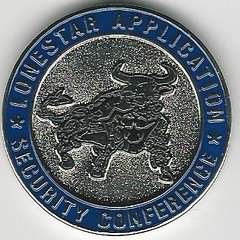
PREV ARTICLE
NEXT ARTICLE
FULL ISSUE
PREV FULL ISSUE
NUMISMATICS AND CRYPTOGRAPHYMichael E. Marotta submitted this essay on numismatics and cryptography, inspired by a new film about Alan Turing and WWII
codebreaking. Thanks! -Editor
The Imitation Game is a new movie, released December 25, 2014, about the cryptanalysts at Bletchley Park. Keira Knightley plays the role of Joan Clarke. Joan Elisabeth Lowther Murray (nee Clarke) was a brilliant mathematician, and an accomplished code-breaker. Clarke was also a numismatist. The British Numismatic Society granted her a Sanford Saltus Gold Medal in 1986. By then she was married; and to the BNS, she was Joan E. L. Murray. You can find a brief biography in Wikipedia, of course, but as Joan Clarke. Lord Stewartby (Bernard Harold Ian Halley Stewart), one of her collaborators in the coinage of Scotland, wrote the obituary for the British Numismatic Journal Vol. 67 No. 13, pg 162-167) That essay provides a bibliography, including papers she read but did not publish. It also closes with a brief report by her, “Dating the End of the Robert Profile Groats.” Her husband, Lieutenant-Colonel John Kenneth Ronald (Jock) Murray, who also worked at the Government Communications Headquarters, introduced her to the problems attendant in sequencing the gold unicorns and heavy groats of the kings James III and James IV of Scotland. Joan E. L. Murray stands out among Saltus awardees for having done all of her work in the area of Scottish numismatics. The intersection of numismatics and cryptography may be a rich field. We know that Masonic Pennies present cryptic messages. (I suggest that the earliest known coins, lumps of electrum with a simple punch could also have been created as gate passes to secret meetings.) Coins with secret compartments are well known to us; and they are associated with spies and smugglers. Since the invention of the Alberti cipher disk in 1467, the “decoder ring” has been a collectible. Sometimes collectors of cryptographic memorabilia call them “cipher coins.” They continue today because they are popular with geocachers. Geocaching is a treasure hunting game that includes both tracking via GPS coordinates and the unraveling of secret messages at each stop. (For one provider of ornate versions of the classic cipher disk, see TheCachingPlace.com.) The museum shop of the National Security Agency has sold replicas of the Confederate cipher disk of the War Between the States. Computer security professionals have taken up the military challenge coin; and included codes ciphers and hidden messages in them. The SANS Institute (www.sans.org) delivers computer security training. An important feature of computer security is penetration testing (“pen testing” for short). At conventions, workshops, and club meetings, computer security enthusiasts often have “capture the flag” challenges in which hackers attack a computer that is defended by a knowledgeable team. Some SANS Institute trainers have created challenge coins as awards and rewards.   Successful students are called “forensicators”. “The Coin, Round Metal Object (RMO), is designed to be awarded to those who demonstrate exceptional talent, contributions, or helps to lead in the digital forensics profession and community. The Coin is meant to be an honor to receive it; it is also intended to be rare. Those who join the Lethal Forensicators Unit will have all privileges and recognition.” The coins quickly evolved into a set with embedded codes and ciphers. The superior student now must win each of the coins in turn and then solve the puzzle. Earlier this year, my wife, Laurel, and I volunteered to work the Lone Star Application Security Conference (LASCON). Our convention badges were metal plaquettes on which were printed in thin disguise the first key to a puzzle. Each clue led to another. Laurel solved the challenge and won a coin. To read the complete article, see:
To read the complete article, see:
To read the complete article, see:
 Wayne Homren, Editor The Numismatic Bibliomania Society is a non-profit organization promoting numismatic literature. See our web site at coinbooks.org. To submit items for publication in The E-Sylum, write to the Editor at this address: whomren@gmail.com To subscribe go to: https://my.binhost.com/lists/listinfo/esylum All Rights Reserved. NBS Home Page Contact the NBS webmaster 
|